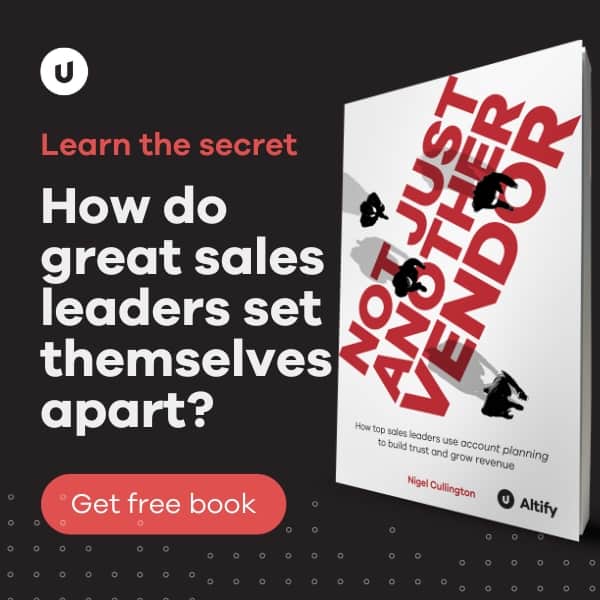Knowing your Customer’s business
Much has been said about the need to bring insights to your customers. In today’s world of more informed buyers, it is clear that you need to do more than just communicate the capabilities of your product. However, not much has been written about how to do this well or consistently. Sellers are struggling to know where to start, and some sales and marketing organizations flounder when trying to build an ‘insight machine’ that scales. How can you ensure that your insight machine (a) delivers insights that customers appreciate and (b) guides them to your solutions?
According to Forrester Research, 64% of senior executives believe that the sales person does not know enough about their buyer’s business to bring any value to a meeting. In fact only 25% of them are prepared to take a second meeting. Think about this for a minute; three out of every four sales meetings are a waste of time and money – both for the seller and for the buyer.
Recent research from SiriusDecisions indicates that providing industry and business expertise is four times more valuable than having product knowledge and developing good relationships.
A seller who adopts the buyer’s perspective in his approach to a customer meeting will engage a buyer more effectively. This is because he sees things as the buyer does. He inhabits their world, and speaks to their pains, challenges, and fears. Using insights as a core part of the sales engagement strategy forces this perspective and results in more successful sales calls.
Building Credibility:
Sometimes we can forget that being a customer is not necessarily easier than being a sales person. All the customer’s got to do is pick a supplier, right? But when the customer makes that buying decision, the risk shifts from the supplier to the customer. For a customer to be comfortable, she must be really sure that the supplier actually understands her needs. Demonstrating knowledge of your own products or solutions doesn’t help. You need to help the customer learn something (worthwhile) that she doesn’t already know. That’s how you build credibility.
The Recipe for a Great Insight – 5 Ingredients:
1. Start with the ‘typical’ customer problem scenario.
Companies of a similar size, at the same stage of company maturity, in the same region, and serving the same markets tend to have similar business challenges. All customers are different, but few have truly unique problems – just problems that are not sufficiently well understood at a detail level in the context of that customer.
A customer problem scenario is composed of the following:
- Goals: Key business requirements, what we want to achieve
- Pressures: these are directly affecting our ability to reach our goal
- Initiatives (or Projects): we undertake these to overcome the pressures and achieve our goals
- Obstacles: these stand in the way of our goal. They’re the things that are broken that we need to fix, or problems in need of a solution that we create before we can be successful.
Remember, obstacles aren’t a bad thing- they’re the reason our product exists in the first place- we build products to fix something that’s broken, and fill a gap in the market.
We applied this approach to our own Dealmaker products, creating a way for you to track and build a ‘typical’ customer problem scenario for your own products and customers.
2. Consider the Buying Personas.
Companies don’t buy – people do. In a typical B2B scenario there will be multiple personas involved in the buying decision. Each of these will have different concerns and issues that they care about.
To reach a Great Sales Insight, design your approach with the buyer in mind.
In this example, Bob, VP of Sales, has different concerns to Paul, the CIO. We provide them with different insights according to their particular concerns. For example, Bob might benefit from a whitepaper talking about how easy it is to use this product on mobile, and how mobile is so important right now for productivity. Meanwhile, Paul the CIO will appreciate a discussion of cost, perhaps comparing the cost of SaaS to on-premise software.
3. Make it interesting – add intrigue.
Teach the customer something they didn’t know before.
Your buyer will tell you their needs, and it’s important to address them and to demonstrate how your solution can meet those needs. But that’s not all you should provide. Try to introduce something new to the table to make it interesting.
It’s a lot more valuable if you can create that ‘Aha’ moment when the buyer says “That’s interesting, I never thought about it that way before – I can see how we might benefit from that approach”.
4. Lead to your solution.
You can create an insight that leads to your solution if you have a deep understanding as to why the product was developed in the first place.
This is where sales enablement and product marketing / management can deliver dramatic value to the sales team by synthesizing those specific capabilities that your product uniquely delivers that the customer should value, based on your understanding of their business. You want to use the insight to lead to your product’s capabilities mapped to the customer’s known or unknown needs, rather than use traditional marketing approaches to lead with the product.
5. Do Not (overtly) Self-Promote.
The insight you provide should have intrinsic value.
Good examples of insights are things like 3rd party studies, survey results, or industry analysis. Anything that is overtly self-promotional, and presented as an insight does more harm than good. Datasheets, customer testimonials, or demo videos are not insights. Insights should really be vendor agnostic. Bear in mind that you are asking the buyer to spend their time consuming whatever you provide. Does the insight add value to their job? You should be using the insight to build credibility.
Following the 5 steps above will help you create valuable Sales Insights for your buyer that add credibility for you and help the buyer understand more about their problem so you can engage them in meaningful conversation.
Make it scale:
We’d love to see more examples of sales and marketing organizations that package insights in a manner that can be consumed easily by an individual sales person and then shared with the customer. Few organizations have put the infrastructure in place to scale such a solution consistently across a sales teams.
What we are doing here with insights is designing for a crucial component of the buyer / seller interaction; the point at which credibility grows or dies. It is not reasonable (or responsible) to ask all of your salespeople to figure this out themselves. They just don’t have the time and are not as close to the problem as your product people were when they were building the product, or where your sales enablement people or product management / marketing should be. In many cases you will end up with marketing collateral masquerading as insights; or insights that are only lightly-informed and can’t flex when faced with any level of analysis; or, at worst, insights that have not been thought through well enough and in fact lead to a capability that you cannot provide.
Winning sales teams gather all of the raw information available from product experts, from marketing and customers, to deconstruct, process and repackage it with smart software so that everyone – sales, marketing and all customer facing personnel in your company – can apply it to facilitate good business conversations with customers that lead to the right solutions.



